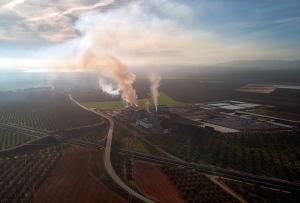
Parties to the UNECE Convention on Long-range Transboundary Air Pollution (Air Convention) have agreed to work to revise the Protocol to Abate Acidification, Eutrophication and Ground-Level Ozone (Gothenburg Protocol), which is expected to further strengthen efforts to reduce air pollution in Europe and North America.
The ground-breaking decision came on 14 December as a result of follow-up discussions on policy options to address the findings of the recent review report, which had assessed the effectiveness of the amended Gothenburg Protocol. The review report found that that while emission reductions have been achieved, countries in the Pan-European region and North America are set to suffer long-term damage from air pollution to human health, ecosystems, crop yields, and climate . As current efforts will not be sufficient to avoid these harmful effects, further targeted emission reduction measures across sectors including agriculture, energy, transport and shipping, and wide-ranging societal changes in areas such as diet and heating, are needed. In addition to further reductions needed in emissions of nitrogen oxides (NOx), volatile organic compounds (VOCs) and methane (CH4) within the region, global CH4 reductions are also needed to further reduce ground-level ozone (O3) in the region.
The amended Gothenburg Protocol, in force since 2019, is the only binding regional treaty anywhere in the world to regulate major air pollutant emissions. It already supports 28 Parties – including the European Union, the UK, the US and Canada – to deliver significant emissions cuts.
UNECE Executive Secretary Tatiana Molcean stated: “By agreeing to further strengthen this instrument, governments in the region are demonstrating their commitment to take integrated, multilateral action on air pollution that will benefit health, ecosystems, food production and the climate. I therefore urge negotiators to ensure the revisions to the Gothenburg Protocol will enable Parties to deliver ambitious emissions cuts and call on policymakers to ensure the required measures for full implementation.”
Given the results from the review of the Gothenburg Protocol, Parties agreed to consider revisions to the following issues, among others: new emission reduction commitments for the pollutants currently covered by the Protocol; potential revisions of technical annexes including with regard to their level of ambition and scope; how to deliver further reductions of black carbon emissions; whether and how to address methane emissions; how to achieve additional ammonia emission reductions; new flexibilities, and other approaches for non-Parties to facilitate ratification and subsequent implementation of the Protocol; overarching, collective risk-based target(s) to reduce risk to health and ecosystems in the region; how to achieve integrated approaches among climate, energy and air policies.
New Guidance
As a response to the findings of the review, Task Forces under the Convention have already worked on further technical guidance to assist Parties in reducing emissions from specific sources mentioned in the review report, specifically, agriculture, shipping, waste and energy.
Parties adopted new guidance on co-mitigation of methane and ammonia emissions from agricultural sources (accounting for around half of anthropogenic methane emissions) and technical measures for reduction of methane emissions from landfill, the natural gas grid and biogas facilities, which are other major sources.
Parties also adopted new guidance for reduction of emissions from shipping. Despite a significant reduction in the sulfur content of marine fuel oil, marine shipping is the largest source of SO2 per ton-km of all transport modes, and is also a significant source of NOx and PM. Around 70 per cent of shipping emissions are generated less than 400 km offshore and can travel hundreds of km onshore, affecting people in densely populated coastal cities and beyond. Best Available Techniques to reduce emissions from shipping include fuel switching, combustion modification, and adjustment in the propulsion mode.
Work to revise the Gothenburg Protocol will start at the sixty-second session of the Working Group on Strategies and Review (Geneva, 27–31 May 2024).
About the Air Convention
The UNECE Convention on Long-range Transboundary Air Pollution was adopted in 1979. Over the years, it has been extended by eight protocols that identify specific measures to be taken by Parties to cut their emissions of air pollutants. The Convention has 51 Parties, covering North America and almost the entire European continent.
The amended Gothenburg Protocol establishes legally binding emissions reduction commitments for 2020 and beyond for the major air pollutants: sulphur dioxide (SO2), nitrogen oxides (NOx), ammonia (NH3), volatile organic compounds (VOCs) and fine Particulate Matter (PM2.5). Adopted in 2012 and entering into force in 2019 and with 28 Parties to date, the amended Protocol is already supporting action for clean air in a number of countries.

